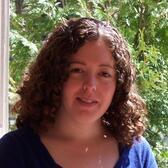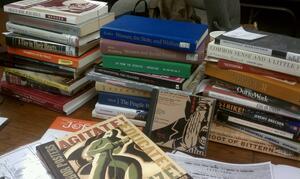Being a Good Ally, on One Foot
In my job as staff writer for the Jewish Women’s Archive, I write short profiles about historical and living women. Each one is fascinating—and each presents its own challenges. Are there reliable sources I can use, or do I have to sift through puff pieces? If the only information I can find about someone is a résumé, how do I create some sort of throughline that turns those bullet points into a human story? And hardest of all, if each profile is just 200 words, how do I decide what to include and what to cut?
This is particularly charged because I’m writing about women. There are so many cringe-worthy examples out there of men being remembered for their professional accomplishments while their female colleagues are discussed in terms of family life or appearance. When I first started writing these short profiles, I decided that I would mention a woman’s personal life only if it played an essential role in her story: It made sense for a woman artist whose collaboration with her husband continued even after her death, or a woman whose career was a “second act” after raising children. But in many cases, especially for contemporary women, how many children a woman has and whether she is partnered or single has little relevance to her professional life.
The same goes for someone’s Jewishness. Whether a woman had two Jewish parents, one Jewish parent, or converted generally doesn’t add anything to her story. JWA honors Jewish women from across the spectrum, liberals and conservatives, religious and secular. If their conversion or parentage is important to understanding who they are and the work they do, that’s one thing. Otherwise, if a woman identifies as Jewish, that makes her part of the rich, complex story we’re trying to tell, end of story.
But deciding what to include and what to leave out can get messy. Telling the whole story of Jewish history doesn’t just mean highlighting women in general, it means making sure women of color, lesbians, and transwomen are included. When writing about transwomen, I knew enough to ask whether to refer to them consistently with female pronouns, or switch between calling them “he” or “she” when talking about their lives before and after transition. But other issues were less clear: should I explicitly say that someone is a lesbian to call attention to the fact that not all Jewish women are straight, or does that ghettoize them? More than one gay friend has complained to me over the years, “I’m a lesbian and a writer, but I don’t write about gay subjects; why do I always have to be identified as a lesbian writer?” In an ideal world, I could ask everyone I’m writing about how they want to be identified. But some people are out of reach. Some are dead. In a lot of cases, I just have to make a judgment call.
Until recently, I had decided to use the same policy I had for family life and Jewish identity: if the person was an LGBTQ activist or the first lesbian or transwoman to accomplish something, I mentioned their sexuality or gender identity. If not, then I saw it as part of their personal life, not relevant to a short professional biography. I thought this was what equality meant: treating everyone the same. I made the classic white feminist mistake: assuming one size fits all and forgetting about intersectionality.
Then someone in the gay community gently called me out. By not noting that someone identified as a lesbian, wasn’t I contributing to the long history of making gays and lesbians invisible, of saying their identity was something to be hidden?
She was right, and I was embarrassed for not having seen it sooner. The entire point of the Jewish Women’s Archive is to tell women’s stories that might otherwise be downplayed, made invisible. It is important for young queer Jews to realize they’re not alone, and for all of us to acknowledge that gays and lesbians are an integral part of the Jewish community. But if a lesbian says she wants to keep her personal life and her professional life separate, I can also honor that. In the information age, it’s usually pretty clear when someone doesn’t want to be referred to in a certain way, and I’ve always been respectful of those choices when writing their stories. I can find the answer with a little digging. I just didn’t know to ask the question before.
I try to be a good ally, but here’s something I think gets missed in discussions of how to do that well: being a good ally doesn’t mean treating others the way you’d want to be treated, it means treating others the way THEY want to be treated. It means asking questions. And isn’t that always how we hear the best stories?







